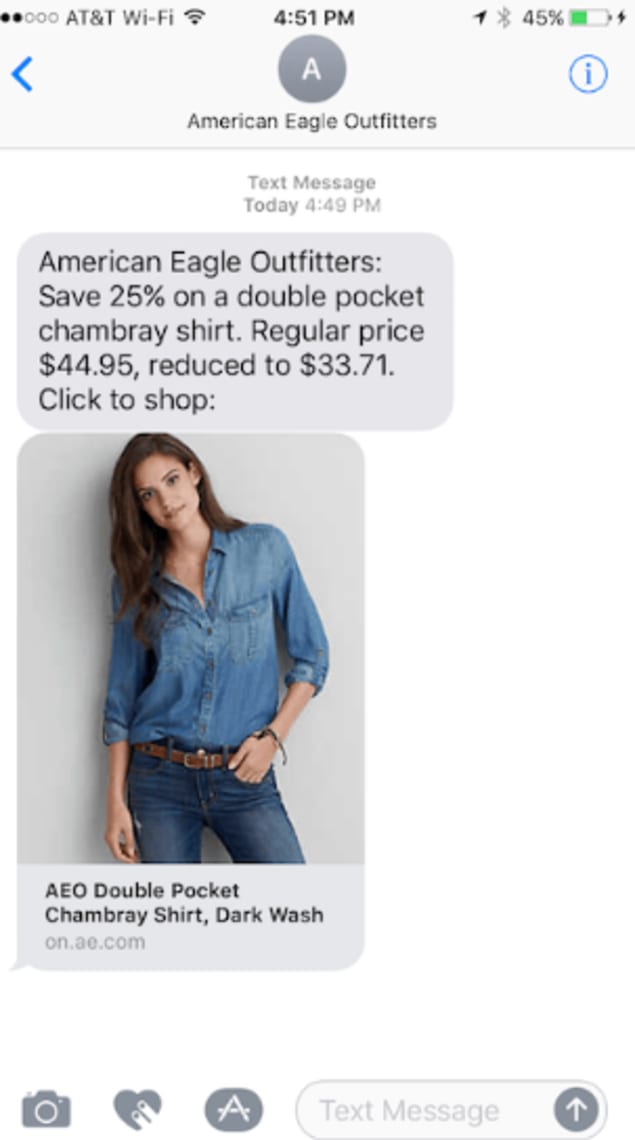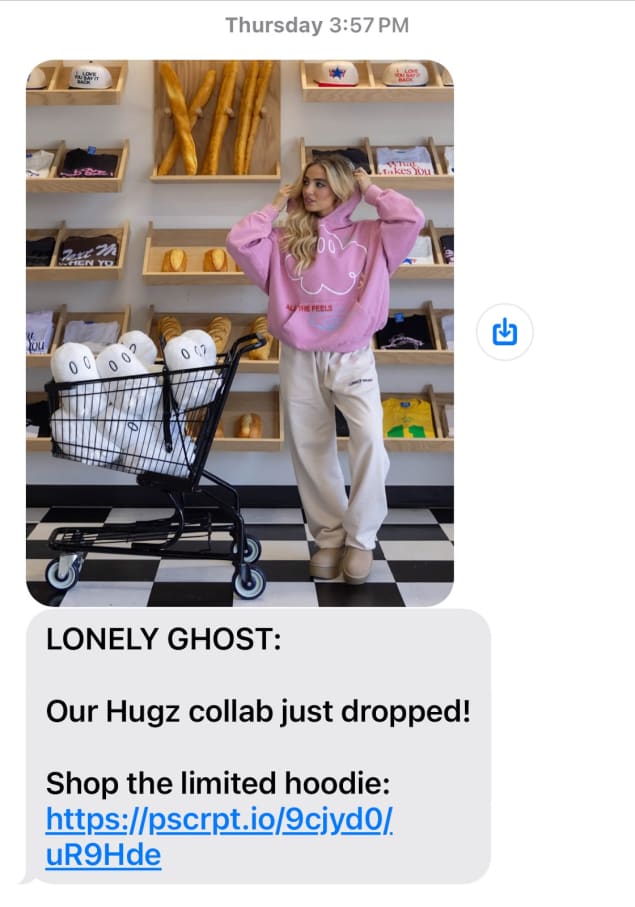What’s the difference between “that’s funny!” and “that’s funny.” in a text message? The words might be the same, but the meaning is entirely different. The reason? Punctuation sets the tone of the text message. While the exclamation point is a universally acknowledged symbol for expressing excitement, things like sarcasm cannot be expressed easily over text. As a result, millennials have evolved entirely new rules to communicate a spectrum of emotions on text, built entirely on the use of punctuation or lack thereof. In this world, periods are used to communicate sarcasm, even aggression.
Millennials have their own unique rules for texting, and Gen Z has its own — whichever side you’re on, chances are that you’ve been filled with incredulity when texting with someone from the other generation. When it comes to SMS marketing and text messaging, it’s critical to know your audience and the way they interpret texts. Speak in a language — and in a way — that they understand. Here’s what to keep in mind when texting a younger crowd.
Crafting The Perfect Text Messages For Marketing to Millennials
Punctuations set the tone of your text message marketing
We’ve already seen how punctuation can change the sentiment of a text message. So how do you maintain sentence structure and clearly convey your ideas if your audience detests periods? You’ll need to get creative. Consider this example:
Hi Maria! I hope you’re loving your new 👠! If you are, be sure and rate them ⭐️⭐️⭐️⭐️
Here’s a free gift of 10% off your next pair: SHOES10
There are four sentences in that example, and no periods. Two exclamation points exude a tone of excitement, reeling the recipient of the text in. The star emojis break up the text and offer a clear prompt. Finally, there’s no need for punctuation on the last sentence, since it ends in a coupon code (or link). Voilà! A text message that any Millennial will easily read and get the right sentiment from.
Exclamation points aren’t the only way to set the tone in a text to younger audiences. Here’s a quick cheat sheet for how your punctuation gets perceived:
- Period (.): A statement that’s formal and final.
- Exclamation point (!): ****Genuine excitement and positivity.
- Question mark (?): Genuine inquisition and curiosity.
- Interrobang (?!): Puzzled surprise or startled amazement.
- Ellipses (…): Rhetorical or suggestive sentiment.
It’s also common to use emojis to break up sentences, as a sort of punctuative statement at the end of a thought.
Emojis need to serve a purpose
Speaking of emojis, SMS marketers need to get very familiar with what they mean and how to use them when texting with millennials. Your choice of emoji has a big impact on the words you use alongside them. A single emoji can change the entire feel of a sentence. For example:
- Have you tried our new Butterscotch Latte? 🤤
- Have you tried our new Butterscotch Latte? 🚨
- Have you tried our new Butterscotch Latte? ❄️
Though they say the same thing, each message offers a different meaning. The first emoji evokes a delicious connotation to kickstart someone’s cravings. The second emphasizes that it’s a new product, appealing to a person’s sense of curiosity. The last emoji implies a seasonal slant, which might trigger urgency — “get it before it’s gone.”
Emojis can also help you cut down the length of your message and save you valuable characters — especially when you’re trying to keep the cost of your messaging low.
Through emojis, you can say a lot by saying almost nothing at all. Just make sure your emojis serve a purpose. Packing them into an SMS marketing message will come off as insincere — or worse, confuse the message you’re trying to send. Keep your emoji game on-point and make sure they add value to your text messages.
The less you say, the better
Texting is a short-form medium: short message service (SMS). Keep your sentiments short, sweet and to-the-point! The length of your text makes a statement about what you’re trying to say. It happens on a bell curve:
- Extremely short texts of 1-5 words are too curt and come off brash.
- Texts spanning 1-2 sentences are great, but need to have succinct meaning.
- Texts as long as 2-5 sentences are ideal, so long as the sentences are simple.
- Messages that are 1 paragraph are complex and might just be skimmed.
- Extremely long texts of multiple paragraphs will likely be ignored outright.
Depending on what you need to say, you’ll want to keep SMS marketing texts between 2-5 sentences. One or two sentences are okay if you make a clear, meaningful point. You might also be able to get away with a paragraph, provided it’s a short one that has immediate and apparent value for the reader.
So, what should you say? Be direct and specific, while keeping your tone positive. In a 2-5-sentence text, your cadence might look something like this:
- Positive, personal introduction
- Thankful or appreciative statement
- Question relevant to the recipient
- Prompt or call to action
- Link or actionable item
Depending on the nature of the email — to solicit a review or encourage an order, for example — you might omit sentence one, two or three. What matters is that your message is quickly read, easily processed and valuable to the reader.
Personalize the text message
The most egregious mistake you can make in texting Millennials or a Gen Z audience is to spam them. If the message isn’t personal or relevant, it’s spam. The quickest way to land your business on a blocked caller list is to market indiscriminately.
There are a few core elements that distinguish SMS marketing from a spam text. Make sure you include as many of the following as possible:
- The recipient’s name
- Pertinent detail that ties them to the message
- A core takeaway that’s relevant to them
- A real value proposition or incentive
- An authentic tone and sentiment
A millennial-friendly marketing text might read as: Hi [Name]! Planning a date night? 🍷 Join us at [Wine Bar] tonight for a cozy evening of great wine and even better company. We’ll help you find the perfect pour—see you soon?
If your message sounds generic, feels impersonal or lacks authenticity, your audience will likely read it as spam. SMS marketing needs to feel like it’s coming from another person — that is, after all, the point of a text message conversation.
Additional Ideas for Effective Millennial Text Message Marketing
A Picture is Worth 1,000 Words, Especially When Texting with Millennials
Visual storytelling has a universal appeal, but it’s particularly effective when marketing to millennials and younger generations. These groups respond more positively to engaging visuals, making graphics a critical component of SMS campaigns aimed at capturing their attention.
A strategically chosen image can do more than just enhance the appearance of a text message—it can make your message unforgettable and drive action. Whether you’re promoting half-off smoothies or showcasing your latest shoe inventory, pairing your offer with a compelling graphic can entice your millennial audience to take the next step.

Additionally, it’s important to understand that millennials and younger consumers prioritize experiences over material goods more than older generations do. To maximize the impact of your visuals, consider A/B testing images that feature vivid, dynamic scenes against simpler ones with blank backgrounds. This approach will help you identify what resonates most with this experience-focused demographic, ensuring your messaging drives both engagement and results.
Millennials Value Innovation and “Freshness”: Craft Marketing Texts About What’s New and Exciting for Your Brand
Millennials and younger generations have a strong affinity for what’s new and exciting. In today’s fast-paced digital landscape, platforms like TikTok have amplified their appetite for the latest trends, making them quick to embrace innovation. As a result, brands must stay ahead by crafting marketing texts that highlight fresh offerings and cutting-edge ideas.
Spotlight new products in your SMS campaigns, especially those tied to viral topics or cultural moments. Whether it’s a limited-edition collaboration, a trending menu item, or a product that aligns with seasonal buzz, framing your text around what’s timely and relevant will capture their attention and enthusiasm.
To further engage this audience, reward your SMS subscribers with more than just discounts. Offer them early access to much-anticipated or exclusive releases. Giving your loyal subscribers a first look at buzz-worthy products not only reinforces their connection
Millennials Care About a Brand’s Principles and Positive Impact: Share Your Good Work Through SMS
Millennials and younger generations are increasingly driven by a brand’s principles and its perceived positive impact on the world. According to Forbes, these consumers are more likely to choose brands whose values align with their own, making it essential for companies to communicate their commitment to doing good.
SMS is an ideal channel for highlighting your contributions to the community, particularly at the local level. Text messages allow for direct, personalized communication, helping your brand connect authentically with its audience. For instance, consider sending messages that not only inform but inspire, such as:
“Hi [Name]! We’re excited to see you at the St. Jude’s Run this Sunday! Don’t forget to stop by the [Brand] booth—every dollar goes to support St. Jude Children’s Research Hospital. See you there!”
This type of messaging not only demonstrates your company’s positive impact but also fosters a sense of community and shared values. By using SMS to spotlight your philanthropic efforts, you can build deeper connections with millennial consumers while reinforcing their loyalty to your brand.
Consider How SMS Builds Off of Your Other Marketing Touchpoints
While SMS is a powerful tool, it’s essential to remember that it doesn’t exist in isolation. Millennials engage with brands across multiple channels, and their interactions with your text messages are influenced by the broader marketing ecosystem. To maximize impact, think of SMS as a complementary layer that enhances and builds on the momentum of other marketing efforts.
For example, you could start by posting eye-catching graphics of your spa’s new facial treatment on social media or collaborating with local influencers to review it for their followers. These initial efforts generate buzz and anticipation, laying the groundwork for engagement. A few days later, follow up with a targeted text message offering a 15% discount on the new treatment, tapping into the excitement you’ve already created.
This integrated approach amplifies the effectiveness of your SMS campaigns by leveraging the energy and awareness from other channels. By aligning your text messages with your broader marketing strategy, you create a cohesive, engaging experience that resonates with millennial audiences.
Don’t Confuse Millennials for Gen Z
Millennials, once the vanguard of cultural trends, are no longer the youngest, trend-setting generation. While they’ve paved the way for digital-first experiences, their priorities have evolved as they’ve entered new life stages. Many millennials now juggle careers, families, and the myriad responsibilities that come with being full-fledged adults.
As a result, it’s important to tailor your messaging accordingly. Avoid using Gen Z slang or overly niche cultural references that might come across as inauthentic or irrelevant to a millennial audience. Instead, focus on crafting messages that align with their current interests, like balancing convenience with quality, prioritizing experiences, and aligning with brands that share their values.
Don’t Make Assumptions About the Text Recipient Just Because They’re a Millennial
Millennials are often grouped together as a single, homogenous audience, but this couldn’t be further from the truth. As the largest living generation, millennials represent an incredibly diverse group with varying worldviews, buying preferences, and socioeconomic statuses. Assuming a one-size-fits-all approach can lead to missed opportunities to connect authentically with this important demographic.
Instead of relying on generalizations, invest time in understanding your specific customer base.
- Begin by engaging in social listening to observe what topics, trends, and conversations matter most to your audience.
- Combine this with market research to uncover insights into their preferences, behaviors, and purchasing triggers.
- Finally, A/B test your SMS campaigns to see what type of messaging resonates best. For instance, you might test promotional offers versus experiential messaging to determine what drives higher engagement among your millennial audience.
Seeking more inspiration? Check out 9 Creative Marketing Text Message (SMS) Ideas & Examples.
Bonus SMS Opportunity for Connecting with Millennials: Customer Service
While customer service is not traditionally viewed as part of marketing, it plays a crucial role in lead nurturing, customer retention, and building long-term brand loyalty. A single positive experience can turn a one-time customer into a loyal advocate, while a negative interaction can have the opposite effect, driving them away—and possibly sharing their frustrations online.
Millennials, more than older generations, appreciate SMS-based, two-way service interactions, and it’s easy to see why. SMS customer service offers several key benefits:
- Convenience: Customers can send and receive messages on their own time without being tethered to a phone call.
- Efficiency: Quick, direct responses reduce wait times and frustration.
- Personalization: SMS interactions can be tailored based on customer history and preferences.
- Record Keeping: Customers have a clear, searchable record of conversations.
- Fewer Barriers: Texting feels more natural and less intimidating for many, particularly younger customers.
Moreover, modern tools like Voxie enable franchises and other businesses to elevate SMS-based customer service beyond what was possible even a few years ago. This is largely thanks to:
- Conversational intelligence, which ensures more natural, engaging interactions.
- Machine learning, allowing SMS AI to adapt to your brand’s unique voice and customer needs.
- Advanced integrations, which save past interactions and tailor responses to create a seamless, personalized experience.
By leveraging these capabilities, businesses can use SMS not only to resolve issues but also to deepen relationships with millennial customers. These interactions build trust and loyalty, transforming customer service into a powerful driver of business growth.
For greater insights, read SMS Customer Support - How to Do it Right.
Tailor Your SMS Marketing to Millennials with Voxie
When it comes to reaching millennials effectively, Voxie stands out as the premier conversational SMS marketing platform. Designed with modern businesses in mind, Voxie offers advanced tools to help you craft targeted, engaging, and highly personalized campaigns that resonate with millennial audiences.
Here’s how Voxie’s capabilities set you up for SMS marketing success:
- List Segmentation: Voxie ensures your millennial-focused texts reach the right audience by enabling precise list segmentation. This means your campaigns are tailored specifically for millennials, rather than being sent to a broad, mixed-age audience where they might lose relevance.
- Personalization: Millennials value messaging that feels tailored to them. With Voxie, you can dynamically include names, preferences, and past purchase details in your texts, creating a connection that goes beyond generic mass messaging.
- Drip Campaigns: Keep millennials engaged over time with strategic drip campaigns. Voxie allows you to schedule a series of messages that guide recipients along the customer journey, whether it’s introducing new products, nurturing loyalty, or driving repeat purchases.
- Two-Way Communication: Millennials appreciate brands that listen and respond. Voxie’s conversational SMS capabilities enable genuine two-way interactions, making it easy for customers to ask questions, provide feedback, or confirm details without the hassle of phone calls or emails.
- Rich Media Options: Visual storytelling is key to millennial engagement. Voxie allows you to include images, GIFs, and other media in your texts, making your messages more eye-catching and impactful.
By combining these features, Voxie empowers businesses to connect with millennials on a deeper level, driving both engagement and results.
Ready to see how Voxie can elevate your SMS marketing? Learn more about Voxie today and start creating campaigns that truly resonate with your audience!
Additional Ideas for Effective Millennial Text Message Marketing
Creating impactful SMS marketing for millennials requires understanding their values, preferences, and digital habits. Here are some essential tips for crafting messages that resonate with this tech-savvy, socially-conscious generation:
1. A picture is worth 1,000 words, especially when texting with millennials
Visual storytelling resonates with all generations, but millennials, in particular, respond well to eye-catching, relevant images in text messages. A strategically chosen graphic can make your marketing message more memorable and inspire immediate action. Promoting half-off smoothies or new shoe inventory? Include vibrant images or GIFs within your texts to engage your millennial audience.

Millennials are experience-focused, so consider A/B testing images that feature vivid, dynamic backgrounds against simpler, blank settings. This approach lets you find out what type of marketing visuals drive the most text engagement.

2. Millennials value innovation and “freshness” so craft marketing texts about what’s new and exciting for your brand
Millennials value brands that keep up with the latest trends, so keep your content fresh and exciting. This generation’s appetite for new experiences has only increased with platforms like TikTok, which set trends almost overnight. Therefore, catch the eye of your millennial subscribers by showcasing what’s buzzworthy within your SMS marketing messages, particularly products or topics that tie into popular culture.
To make your text marketing offers more enticing, consider giving millennials early access to trending products or events. By positioning them as insiders with special perks, you tap into their desire for exclusivity and innovation.
3. Millennials care about a brand’s principles and positive impact, so why not convey your company’s good work through SMS?
Millennials care about a brand’s values and are more likely to support companies that contribute positively to their communities. With this in mind, use text marketing as a platform to highlight your brand’s principles, especially during local events or community initiatives.
For example, a text like, “Hi [Name]! We’re excited to see you at the St. Jude’s Run this Sunday! Every dollar raised goes to support St. Jude Children’s Research Hospital,” helps millennials connect emotionally with your brand’s mission.
By drawing attention to your contributions to your community, you’re offering more than just a product or service—you’re sharing values that matter to your millennial audience.
4. Consider how SMS builds off of your other marketing touchpoints
SMS is one of many interactions millennials will have with your brand—your text marketing doesn’t occur in a vacuum. For maximum impact, consider how your messages can amplify momentum from other channels. For instance, if you’re launching a new spa treatment, post vibrant graphics on social media and partner with influencers to generate excitement. Follow up with an SMS offering a 15% discount, tapping into the pre-established buzz to drive conversions through multiple touchpoints.
5. Don’t mistake millennials for Gen Z
Millennials are no longer the newest generation on the block; they’re adults with careers, families, and a wide range of responsibilities. Avoid Gen Z slang or cultural references that might feel irrelevant or forced. Instead, focus on authentic communication, recognizing that millennials appreciate practicality just as much as innovation.
6. Don’t make assumptions about the text recipient based on the fact that they’re a millennial
As the largest generation, millennials are diverse, representing various lifestyles, buying preferences, and economic backgrounds. Invest time in understanding your specific millennial customer base through social listening, market research, and A/B testing different text message formats. This nuanced approach will help you tailor your messaging to fit the unique characteristics of your millennial audience, increasing text marketing engagement and satisfaction.
Seeking more inspiration? Check out 9 Creative Marketing Text Message (SMS) Ideas & Examples.
Bonus SMS Opportunity for Connecting With Millennials - Customer Service
Customer service may not always be considered a marketing function, but it is essential for lead nurturing, customer retention, and building lasting brand loyalty. In fact, each customer interaction can significantly shape a brand’s reputation; a positive experience fosters trust, while a negative one can quickly erode it.
Millennials, in particular, are more likely than older generations to appreciate SMS-based, two-way service interactions. Here’s why:
- Instant Responses - Text messaging enables fast, convenient responses, which millennials appreciate for resolving issues quickly without the wait times associated with calls or emails.
- Convenience and Flexibility - SMS customer service allows millennials to interact at their own pace, whether at work or on the go, providing a seamless experience in line with their busy lifestyles.
- Personalized Interactions - With SMS, brands can offer customized responses that feel more personal, creating a stronger connection than standard automated replies.
- Transparency and Documentation - SMS provides a written record of conversations, helping millennials feel secure and informed about their texting-based interactions with the brand.
- Proactive Engagement - SMS allows brands to reach out with relevant updates or assistance, turning potential problems into proactive solutions, which can enhance satisfaction and trust.
Tools like Voxie enhance these interactions further, allowing franchises and businesses to leverage SMS for more sophisticated, two-way customer engagement than ever before. Voxie’s advanced features make it easy to create responsive, personalized customer service experiences:
- Conversational Intelligence With advanced conversational intelligence, Voxie can interpret customer needs and respond in a natural, engaging way.
- Machine Learning Capabilities Voxie’s machine learning allows its SMS AI to learn about your brand and adapt its responses based on customer history, making interactions increasingly relevant over time.
- Integration of Past Interactions By saving previous conversations and integrating with other systems, Voxie tailors responses based on customer history and preferences, providing a seamless, consistent experience.
Incorporating SMS customer service as part of your strategy not only enhances the customer journey but also strengthens millennial loyalty—critical factors for sustained brand success.
For greater insights, read SMS Customer Support - How to Do it Right.
Tailor Your Text Message Marketing to Millennials With Voxie
Voxie is an advanced SMS marketing platform designed to help businesses create meaningful, personalized connections with their customers. With powerful tools and intelligent features, Voxie empowers brands to engage millennials effectively, delivering the right message at the right time to drive results.
Advanced SMS Capabilities for Targeting Millennials
Voxie’s platform is built with flexibility and precision, enabling businesses to target millennials with tailored marketing strategies. Here’s how Voxie helps you craft campaigns that resonate with this tech-savvy and experience-driven generation:
-
List Segmentation
Voxie allows you to segment your audience by demographics, behavior, and preferences. This means you can send millennial-specific messages without unintentionally targeting baby boomers or Gen Z audiences with content that doesn’t apply to them.
-
Personalization
Millennials value authenticity, and Voxie’s personalization features make it easy to address them by name, reference past purchases, or suggest products that align with their preferences. This personal touch creates stronger connections and increases engagement.
-
Drip Campaigns
Voxie’s automated drip campaigns help you nurture leads and build relationships over time. By sending a series of well-timed, relevant messages, you can guide millennials through the customer journey in a way that feels organic and valuable.
-
Two-Way Communication
Voxie enables real-time, two-way conversations, allowing millennials to ask questions, provide feedback, or engage directly with your brand. This interactive approach not only enhances customer satisfaction but also fosters loyalty.
-
Incorporate Visuals
Millennials are highly visual, and Voxie lets you include images in your SMS campaigns. Whether it’s a vibrant photo of a new product or a graphic promoting an event, visuals make your marketing messages more memorable and engaging.
Ready to Elevate Your SMS Marketing?
Voxie is the ultimate solution for businesses looking to connect with millennials on a deeper level. With advanced tools for segmentation, personalization, and two-way communication, Voxie ensures your SMS campaigns are not only effective but also aligned with your audience’s preferences.

About the Author
Ali Spiric
Growth Marketing Manager at Voxie
